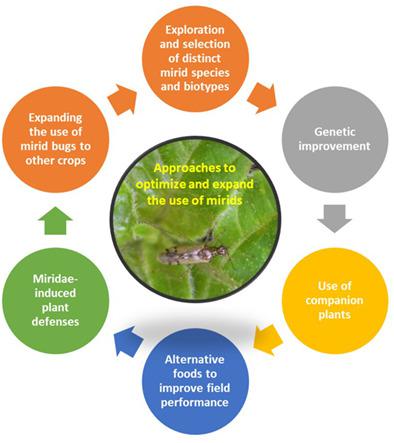当前位置:
X-MOL 学术
›
Pest Manag. Sci.
›
论文详情
Our official English website, www.x-mol.net, welcomes your
feedback! (Note: you will need to create a separate account there.)
Use of zoophytophagous mirid bugs in horticultural crops: Current challenges and future perspectives.
Pest Management Science ( IF 3.8 ) Pub Date : 2020-08-10 , DOI: 10.1002/ps.6043 Meritxell Pérez-Hedo 1 , Chaymaa Riahi 1 , Alberto Urbaneja 1
Pest Management Science ( IF 3.8 ) Pub Date : 2020-08-10 , DOI: 10.1002/ps.6043 Meritxell Pérez-Hedo 1 , Chaymaa Riahi 1 , Alberto Urbaneja 1
Affiliation

|
In recent years, the use of predatory mirid bugs (Hemiptera: Miridae) in horticultural crops has increased considerably. Mirid bugs are zoophytophagous predators, that is, they display omnivorous behavior and feed on both plants and arthropods. Mirid bugs feed effectively on a wide range of prey, such as whiteflies, lepidopteran eggs and mites. In addition, the phytophagous behavior of mirid bugs can activate defenses in the plants on which they feed. Despite the positive biological attributes, their use still presents some constraints. Their establishment and retention on the crop is not always easy and economic plant damage can be caused by some mirid species. In this review, the current strategies for using zoophytophagous mirid bugs in horticultural crops, mainly Nesidiocoris tenuis, Macrolophus pygmaeus and Dicyphus hesperus, are reviewed. We discuss six different approaches which, in our opinion, can optimize the efficacy of mirids as biocontrol agents and help expand their use into more areas worldwide. In this review we (i) highlight the large number of species and biotypes which are yet to be described and explore their applicability, (ii) present how it is possible to take advantage of the mirid‐induced plant defenses to improve pest management, (iii) argue that genetic selection of improved mirid strains is feasible, (iv) explore the use of companion plants and the use of alternative foods to improve the mirid bug management, and finally (vi) discuss strategies for the expansion of mirid bugs as biological control agents to horticultural crops other than just tomatoes. © 2020 Society of Chemical Industry
中文翻译:

园艺作物中食草性虫子的使用:当前的挑战和未来的前景。
近年来,在园艺作物中使用掠食性rid虫(半翅目:Mir科)已大大增加。rid虫是食草动物的食肉动物,也就是说,它们表现出杂食性,以植物和节肢动物为食。rid虫可以有效地捕食各种各样的猎物,例如粉虱,鳞翅目卵和螨虫。此外,mirid bug的植食性行为可以激活其赖以为生的植物的防御能力。尽管具有积极的生物学特性,但它们的使用仍然存在一些限制。它们在作物上的定植和保留并不总是那么容易,而且一些隐性物种可能造成经济上的植物破坏。在这次审查中,对于使用在园艺作物,主要是zoophytophagous mirid错误当前策略Nesidiocoris细叶,lop(Macropophus pygmaeus)和he(Dicyphus hesperus),已审核。我们讨论了六种不同的方法,我们认为这些方法可以优化mirids作为生物防治剂的功效,并有助于将其应用扩展到全球更多地区。在本综述中,我们(i)着重说明尚未描述的大量物种和生物型并探讨其适用性,(ii)提出如何利用the虫诱导的植物防御来改善有害生物管理,( iii)认为对改良的mirid菌株进行遗传选择是可行的,(iv)探索使用伴生植物和使用替代食品来改善mirid bug的管理,最后(vi)讨论将mirid bug作为生物进行扩展的策略除番茄以外,园艺作物的控制剂。©2020化学工业协会
更新日期:2020-08-10
中文翻译:

园艺作物中食草性虫子的使用:当前的挑战和未来的前景。
近年来,在园艺作物中使用掠食性rid虫(半翅目:Mir科)已大大增加。rid虫是食草动物的食肉动物,也就是说,它们表现出杂食性,以植物和节肢动物为食。rid虫可以有效地捕食各种各样的猎物,例如粉虱,鳞翅目卵和螨虫。此外,mirid bug的植食性行为可以激活其赖以为生的植物的防御能力。尽管具有积极的生物学特性,但它们的使用仍然存在一些限制。它们在作物上的定植和保留并不总是那么容易,而且一些隐性物种可能造成经济上的植物破坏。在这次审查中,对于使用在园艺作物,主要是zoophytophagous mirid错误当前策略Nesidiocoris细叶,lop(Macropophus pygmaeus)和he(Dicyphus hesperus),已审核。我们讨论了六种不同的方法,我们认为这些方法可以优化mirids作为生物防治剂的功效,并有助于将其应用扩展到全球更多地区。在本综述中,我们(i)着重说明尚未描述的大量物种和生物型并探讨其适用性,(ii)提出如何利用the虫诱导的植物防御来改善有害生物管理,( iii)认为对改良的mirid菌株进行遗传选择是可行的,(iv)探索使用伴生植物和使用替代食品来改善mirid bug的管理,最后(vi)讨论将mirid bug作为生物进行扩展的策略除番茄以外,园艺作物的控制剂。©2020化学工业协会











































 京公网安备 11010802027423号
京公网安备 11010802027423号